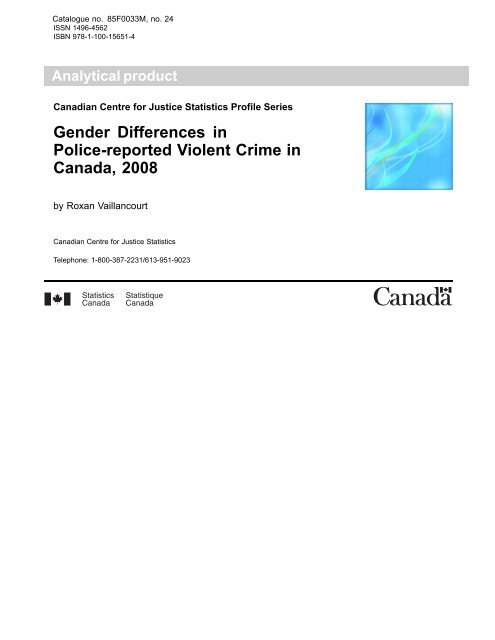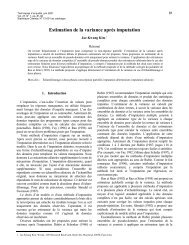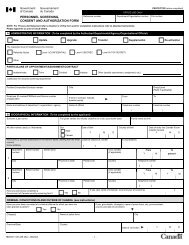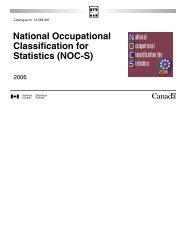Gender Differences in Police-reported Violent Crime in Canada, 2008
Gender Differences in Police-reported Violent Crime in Canada, 2008
Gender Differences in Police-reported Violent Crime in Canada, 2008
Create successful ePaper yourself
Turn your PDF publications into a flip-book with our unique Google optimized e-Paper software.
Catalogue no. 85F0033M, no. 24<br />
ISSN 1496-4562<br />
ISBN 978-1-100-15651-4<br />
..Analytical product........................................................................<br />
Canadian Centre for Justice Statistics Profile Series<br />
<strong>Gender</strong> <strong>Differences</strong> <strong>in</strong><br />
<strong>Police</strong>-<strong>reported</strong> <strong>Violent</strong> <strong>Crime</strong> <strong>in</strong><br />
<strong>Canada</strong>, <strong>2008</strong><br />
by Roxan Vaillancourt<br />
Canadian Centre for Justice Statistics<br />
Telephone: 1-800-387-2231/613-951-9023
How to obta<strong>in</strong> more <strong>in</strong>formation<br />
For <strong>in</strong>formation about this product or the wide range of services and data available from Statistics <strong>Canada</strong>, visit our website at<br />
www.statcan.gc.ca, e-mailusat<strong>in</strong>fostats@statcan.gc.ca, or telephone us, Monday to Friday from 8:30 a.m. to 4:30 p.m., at the<br />
follow<strong>in</strong>g numbers:<br />
Statistics <strong>Canada</strong>’s National Contact Centre<br />
Toll-free telephone (<strong>Canada</strong> and the United States):<br />
Inquiries l<strong>in</strong>e 1-800-263-1136<br />
National telecommunications device for the hear<strong>in</strong>g impaired 1-800-363-7629<br />
Fax l<strong>in</strong>e 1-877-287-4369<br />
Local or <strong>in</strong>ternational calls:<br />
Inquiries l<strong>in</strong>e 1-613-951-8116<br />
Fax l<strong>in</strong>e 1-613-951-0581<br />
Depository Services Program<br />
Inquiries l<strong>in</strong>e 1-800-635-7943<br />
Fax l<strong>in</strong>e 1-800-565-7757<br />
To access this product<br />
This product, Catalogue no. 85F0033M, is available free <strong>in</strong> electronic format. To obta<strong>in</strong> a s<strong>in</strong>gle issue, visit our website at<br />
www.statcan.gc.ca and browse by “Key resource” > “Publications.”<br />
Standards of service to the public<br />
Statistics <strong>Canada</strong> is committed to serv<strong>in</strong>g its clients <strong>in</strong> a prompt, reliable and courteous manner. To this end, Statistics <strong>Canada</strong><br />
has developed standards of service that its employees observe. To obta<strong>in</strong> a copy of these service standards, please contact<br />
Statistics <strong>Canada</strong> toll-free at 1-800-263-1136. The service standards are also published on www.statcan.gc.ca under “About us”<br />
> “Provid<strong>in</strong>g services to Canadians.”
Statistics <strong>Canada</strong><br />
Canadian Centre for Justice Statistics<br />
<strong>Gender</strong> <strong>Differences</strong> <strong>in</strong> <strong>Police</strong>-<strong>reported</strong> <strong>Violent</strong><br />
<strong>Crime</strong> <strong>in</strong> <strong>Canada</strong>, <strong>2008</strong><br />
Published by authority of the M<strong>in</strong>ister responsible for Statistics <strong>Canada</strong><br />
© M<strong>in</strong>ister of Industry, 2010<br />
All rights reserved. The content of this electronic publication may be reproduced, <strong>in</strong><br />
whole or <strong>in</strong> part, and by any means, without further permission from Statistics <strong>Canada</strong>,<br />
subject to the follow<strong>in</strong>g conditions: that it be done solely for the purposes of private<br />
study, research, criticism, review or newspaper summary, and/or for non-commercial<br />
purposes; and that Statistics <strong>Canada</strong> be fully acknowledged as follows: Source (or<br />
“Adapted from”, if appropriate): Statistics <strong>Canada</strong>, year of publication, name of<br />
product, catalogue number, volume and issue numbers, reference period and page(s).<br />
Otherwise, no part of this publication may be reproduced, stored <strong>in</strong> a retrieval system<br />
or transmitted <strong>in</strong> any form, by any means—electronic, mechanical or photocopy—or<br />
for any purposes without prior written permission of Licens<strong>in</strong>g Services, Client<br />
Services Division, Statistics <strong>Canada</strong>, Ottawa, Ontario, <strong>Canada</strong> K1A 0T6.<br />
May 2010<br />
Catalogue no. 85F0033M, no. 24<br />
ISSN 1496-4562<br />
ISBN 978-1-100-15651-4<br />
Frequency: Occasional<br />
Ottawa<br />
Cette publication est également disponible en français.<br />
Note of appreciation<br />
<strong>Canada</strong> owes the success of its statistical system to a long-stand<strong>in</strong>g partnership between<br />
Statistics <strong>Canada</strong>, the citizens of <strong>Canada</strong>, its bus<strong>in</strong>esses, governments and other<br />
<strong>in</strong>stitutions. Accurate and timely statistical <strong>in</strong>formation could not be produced without<br />
their cont<strong>in</strong>ued cooperation and goodwill.
User <strong>in</strong>formation<br />
Symbols<br />
The follow<strong>in</strong>g standard symbols are used <strong>in</strong> Statistics <strong>Canada</strong> publications:<br />
. not available for any reference period<br />
.. not available for a specific reference period<br />
... not applicable<br />
0 truezerooravalueroundedtozero<br />
0s<br />
p<br />
r<br />
x<br />
E<br />
F<br />
value rounded to 0 (zero) where there is a mean<strong>in</strong>gful dist<strong>in</strong>ction between true zero and the value that was<br />
rounded<br />
prelim<strong>in</strong>ary<br />
revised<br />
suppressed to meet the confidentiality requirements of the Statistics Act<br />
usewithcaution<br />
too unreliable to be published<br />
2 Statistics <strong>Canada</strong> – Catalogue no. 85F0033M, no. 24
Preface<br />
This profile focuses primarily on <strong>2008</strong> police-<strong>reported</strong> data obta<strong>in</strong>ed from the Incident-based Uniform <strong>Crime</strong><br />
Report<strong>in</strong>g (UCR2) Survey. Fund<strong>in</strong>g for this profile was provided by the Policy Centre for Victim Issues (PCVI) of<br />
the Department of Justice <strong>Canada</strong>.<br />
A wide variety of topics and issues have been explored through the Canadian Centre for Justice Statistics Profile<br />
Series <strong>in</strong>clud<strong>in</strong>g: crim<strong>in</strong>al victimization and health, household <strong>in</strong>come and victimization, sexual assault, immigrants<br />
and victimization, and hate crime (Refer to the cumulative list of all products published <strong>in</strong> this series to date).<br />
Statistics <strong>Canada</strong> – Catalogue no. 85F0033M, no. 24 3
Table of contents<br />
Highlights 5<br />
<strong>Gender</strong> <strong>Differences</strong> <strong>in</strong> <strong>Police</strong>-<strong>reported</strong> <strong>Violent</strong> <strong>Crime</strong> <strong>in</strong> <strong>Canada</strong>, <strong>2008</strong><br />
1 Introduction 6<br />
2 Overall rates of violent victimization are comparable between males and females 6<br />
3 Female rates of violent victimization higher <strong>in</strong> a majority of jurisdictions 7<br />
4 Rates of violent victimization higher for women than for men <strong>in</strong> many of <strong>Canada</strong>’s largest cities 7<br />
5 Age makes a difference <strong>in</strong> the rate of victimization between the sexes 8<br />
6 Profile of the accused 8<br />
7 Men and women are victims of different types of violent crime 8<br />
8 Physical assaults 9<br />
9 Sexual assaults 10<br />
10 Homicide 11<br />
11 Other violent offences 12<br />
12 Summary 12<br />
13 Methodology 12<br />
14 Def<strong>in</strong>itions 13<br />
15 Bibliography 14<br />
Appendix<br />
I Tables 15<br />
II Cumulative Index 24<br />
4 Statistics <strong>Canada</strong> – Catalogue no. 85F0033M, no. 24
Highlights<br />
• In <strong>2008</strong>, overall rates of police-<strong>reported</strong> violent victimization were comparable between men and women, but the<br />
nature of their victimization differed.<br />
• Females were more likely to be victims of a common assault, the form associated with the least serious physical<br />
<strong>in</strong>jury than males, while males were more likely than their female counterparts to be victims of the most serious<br />
forms of physical assault (levels 2 and 3) and have a weapon used aga<strong>in</strong>st them.<br />
• Female victims of police-<strong>reported</strong> physical assaults were more often victimized by someone with whom they had<br />
a current or former <strong>in</strong>timate relationship; whereas male victims were most often physically assaulted by a stranger<br />
or by someone else outside of the family.<br />
• Females were over 10 times more likely than males to be victims of a police-<strong>reported</strong> sexual assault.<br />
• Males were more likely than females to be a homicide victim, account<strong>in</strong>g for 74% of victims of homicide dur<strong>in</strong>g<br />
a 5-year period between the years 2004 to <strong>2008</strong>.<br />
• More than one-third of male victims of homicide were killed with a firearm, compared to 20% of female homicide<br />
victims.<br />
Statistics <strong>Canada</strong> – Catalogue no. 85F0033M, no. 24 5
<strong>Gender</strong> <strong>Differences</strong> <strong>in</strong> <strong>Police</strong>-<strong>reported</strong> <strong>Violent</strong> <strong>Crime</strong> <strong>in</strong> <strong>Canada</strong>, <strong>2008</strong><br />
by Roxan Vaillancourt<br />
Introduction<br />
<strong>Police</strong>-<strong>reported</strong> data show that the risk of violent victimization among adult males (aged 18 years of age and over)<br />
is comparable to that of adult females. Adult females accounted for 51% or about 152,000 of the 298,000 victims of<br />
violent <strong>in</strong>cidents 1 <strong>reported</strong> to the police <strong>in</strong> <strong>2008</strong>, while some 146,000 victims were male (Table 1, Table 2).<br />
There are many consequences associated with be<strong>in</strong>g a victim of a violent crime <strong>in</strong>clud<strong>in</strong>g <strong>in</strong>juries, <strong>in</strong>creased<br />
stress levels and disruption to day-to-day activities. Accord<strong>in</strong>g to the 2004 General Social Survey (GSS) on<br />
Victimization, 24% of victims who susta<strong>in</strong>ed <strong>in</strong>juries due to a violent victimization sought medical attention and 20%<br />
required bed rest. In addition, 81% of victims experienced some form of emotional reaction such as anger,<br />
confusion or be<strong>in</strong>g fearful, and one-third <strong>reported</strong> hav<strong>in</strong>g problems sleep<strong>in</strong>g (AuCo<strong>in</strong> and Beauchamp, 2007).<br />
Be<strong>in</strong>g a victim of a violent crime may lead <strong>in</strong>dividuals to question their perceptions of crime levels <strong>in</strong> their<br />
neighbourhood and their overall safety. For more than half (52%) of victims of violent crime, the experience had an<br />
impact on their day-to-day activities (AuCo<strong>in</strong> and Beauchamp, 2007).<br />
Despite comparable overall rates of police-<strong>reported</strong> violent victimization, the data show that women and men<br />
experience differences <strong>in</strong> the types of violence experienced, the type of weapon used aga<strong>in</strong>st them and the level of<br />
<strong>in</strong>jury susta<strong>in</strong>ed.<br />
This profile exam<strong>in</strong>es the nature and extent of gender differences <strong>in</strong> police-<strong>reported</strong> violent victimization between<br />
male and female adults aged 18 years and over. It analyses gender differences <strong>in</strong> victimization based on the<br />
prevalence across the prov<strong>in</strong>ces and territories, the type of violent offence, the location of the <strong>in</strong>cident, the presence<br />
and type of weapon used, the level of <strong>in</strong>jury to the victim, the victim’s relationship to the perpetrator, and the age of<br />
the victim.<br />
The analysis primarily uses police-<strong>reported</strong> data collected through the Incident-based Uniform <strong>Crime</strong> Report<strong>in</strong>g<br />
(UCR2) Survey, as well as some data from the Homicide Survey. It is important to note, however, that police-<strong>reported</strong><br />
data reflect only those <strong>in</strong>cidents that have come to the attention of the police. The 2004 GSS on Victimization, for<br />
<strong>in</strong>stance, estimated that 61% of adult males and 74% of adult females who had been violently victimized did not<br />
report the <strong>in</strong>cident to the police.<br />
Accord<strong>in</strong>g to the 2004 GSS, victims of violent crime may not report their victimization to the police for various reasons.<br />
For example, the victim may choose to deal with the <strong>in</strong>cident <strong>in</strong> another way, feel that the <strong>in</strong>cident was not important<br />
enough to warrant contact<strong>in</strong>g the police or not want the police to be <strong>in</strong>volved.<br />
Overall rates of violent victimization are comparable between males and females<br />
<strong>Police</strong>-<strong>reported</strong> data show that <strong>in</strong> <strong>2008</strong>, the rate of violent victimization for female and male victims was<br />
comparable, at 1,155 and 1,150 per 100,000 population, respectively (Table 1, Table 2). Moreover, throughout<br />
1. A victim can be accounted for <strong>in</strong> more than one <strong>in</strong>cident of victimization <strong>in</strong> the same year. Accord<strong>in</strong>g to the 2004 General Social Survey (GSS), victims who<br />
have suffered more than one <strong>in</strong>cident of victimization (33% of victims) accounted for 60% of the total number of victimization. The police-<strong>reported</strong> data<br />
used <strong>in</strong> this report cannot determ<strong>in</strong>e whether the same victim is subject to multiple victimizations. In addition, police-<strong>reported</strong> data refers to the number of<br />
victimizations and not the number of victims.<br />
6 Statistics <strong>Canada</strong> – Catalogue no. 85F0033M, no. 24
Canadian Centre for Justice Statistics Profile Series<br />
the preced<strong>in</strong>g 5-year period from 2004 to <strong>2008</strong>, the rates of violent victimization for men and women rema<strong>in</strong>ed<br />
relatively stable (Chart 1). 2<br />
Chart 1<br />
Rate of violent police-<strong>reported</strong> victimization aga<strong>in</strong>st males and females stable over a 5-year time period<br />
rate per 100,000 population<br />
1,400<br />
1,200<br />
1,000<br />
800<br />
600<br />
400<br />
200<br />
0<br />
Female<br />
Male<br />
2004 2005 2006 2007 <strong>2008</strong><br />
Year<br />
Source(s):<br />
Statistics <strong>Canada</strong>, Canadian Centre for Justice Statistics, Incident-based Uniform <strong>Crime</strong> Report<strong>in</strong>g Survey.<br />
Female rates of violent victimization higher <strong>in</strong> a majority of jurisdictions<br />
Even though for <strong>Canada</strong> as a whole the rates of violent victimization were virtually the same for both sexes, there<br />
were some notable differences <strong>in</strong> the rates of victimization for men and women <strong>in</strong> some prov<strong>in</strong>ces and territories. For<br />
<strong>in</strong>stance, <strong>in</strong> <strong>2008</strong>, female rates of violent victimization were higher than rates for males <strong>in</strong> 10 of the 13 prov<strong>in</strong>ces and<br />
territories, most notably Nunavut and Northwest Territories as well as Saskatchewan (Table 3). Conversely, male<br />
rates of violent victimization were higher than female rates <strong>in</strong> British Columbia, Quebec and Nova Scotia, 3 while for<br />
New Brunswick there was almost no difference <strong>in</strong> the rate of victimization between the sexes.<br />
Rates of violent victimization higher for women than for men <strong>in</strong> many of <strong>Canada</strong>’s<br />
largest cities<br />
<strong>Gender</strong> differences <strong>in</strong> the rates of violent victimization aga<strong>in</strong>st males and females were also observed <strong>in</strong> many<br />
of <strong>Canada</strong>’s Census Metropolitan Areas (CMA). 4 For example, <strong>in</strong> <strong>2008</strong>, Thunder Bay <strong>reported</strong> the greatest<br />
difference <strong>in</strong> the rate of violent victimization for women (1,780) compared to men (1,359) (Table 4). Also, <strong>in</strong> the<br />
CMAs of Peterborough, Kitchener, Brantford, W<strong>in</strong>dsor, Greater Sudbury and Reg<strong>in</strong>a, female rates of violence were<br />
considerably higher than male rates. Conversely, <strong>in</strong> <strong>2008</strong>, male rates of victimization were higher compared to<br />
female rates <strong>in</strong> the CMAs of Trois-Rivières, Victoria, Sherbrooke, Vancouver and Québec.<br />
Overall <strong>in</strong> <strong>2008</strong>, the highest rates of violent victimization aga<strong>in</strong>st men were found <strong>in</strong> the CMAs of Saskatoon, Sa<strong>in</strong>t<br />
John and Halifax, while for women, Saskatoon, Thunder Bay and Reg<strong>in</strong>a were cities with the highest rates of violent<br />
victimization (Table 4).<br />
2. Incident-based trend data are <strong>reported</strong> by a subset of police services that have been consistently report<strong>in</strong>g to the UCR2 Survey s<strong>in</strong>ce 1999. In <strong>2008</strong>, these<br />
police services covered 54% of the population of <strong>Canada</strong> and are not nationally representative.<br />
3. The <strong>2008</strong> data are based upon <strong>in</strong>formation <strong>reported</strong> by police services cover<strong>in</strong>g 98% of the population of <strong>Canada</strong>.<br />
4. A census metropolitan area (CMA) consists of one or more neighbour<strong>in</strong>g municipalities situated around a major urban core. A CMA must have a total population<br />
of at least 100,000 of which 50,000 or more live <strong>in</strong> the urban core. To be <strong>in</strong>cluded <strong>in</strong> the CMA, other adjacent municipalities must have a high degree of<br />
<strong>in</strong>tegration with the central urban area, as measured by commut<strong>in</strong>g flows derived from census data. A CMA typically comprises more than one police service.<br />
Statistics <strong>Canada</strong> – Catalogue no. 85F0033M, no. 24 7
Canadian Centre for Justice Statistics Profile Series<br />
Age makes a difference <strong>in</strong> the rate of victimization between the sexes<br />
For both men and women, rates of police-<strong>reported</strong> violent victimization were highest among young adults<br />
aged 18 to 24, and lowest among seniors aged 65 and over. However, when sex is taken <strong>in</strong>to account among<br />
the various age groups, a notable difference <strong>in</strong> the risk of victimization is observed (Chart 2). Females between<br />
the ages of 18 and 44 <strong>reported</strong> higher rates of violent victimization compared to male victims with<strong>in</strong> the same age<br />
categories, with females 18 to 24 years of age hav<strong>in</strong>g the highest rate of victimization of all victims, regardless<br />
of age or sex. However after age 44, the rates of violent victimization were higher for males compared with their<br />
female counterparts.<br />
Chart 2<br />
Rates of violent victimization higher for females among those between 18 and 44 and for males among those<br />
aged 45 and over, <strong>2008</strong><br />
rate per 100,000 population<br />
3,000<br />
2,500<br />
2,000<br />
Female<br />
Male<br />
1,500<br />
1,000<br />
500<br />
0<br />
18 to 24 years 25 to 34 years 35 to 44 years 45 to 54 years 55 to 64 years 65 years and over<br />
Victim age<br />
Source(s):<br />
Statistics <strong>Canada</strong>, Canadian Centre for Justice Statistics, Incident-based Uniform <strong>Crime</strong> Report<strong>in</strong>g Survey.<br />
Profile of the accused<br />
In general, women most often <strong>reported</strong> be<strong>in</strong>g victimized by men regardless of crime type, and this was the case as<br />
well for male victims. Men were considered the accused <strong>in</strong> 81% of cases of violent victimization aga<strong>in</strong>st women,<br />
and <strong>in</strong> 79% of cases of violent victimization aga<strong>in</strong>st males; whereas females accounted for 10% of victimizations<br />
aga<strong>in</strong>st females and 10% aga<strong>in</strong>st males. These f<strong>in</strong>d<strong>in</strong>gs are supported by results from other studies <strong>in</strong> the United<br />
States, where the majority of perpetrators that came to the attention of the crim<strong>in</strong>al justice system were men (Bureau<br />
of Justice Statistics, 2006; Heimer and Lauritsen, <strong>2008</strong>; U.S. Department of Justice, 2009).<br />
Men and women are victims of different types of violent crime<br />
<strong>Gender</strong> differences <strong>in</strong> police-<strong>reported</strong> victimization are seen <strong>in</strong> the types of violent offences experienced by male and<br />
female victims. Males, for example, are more likely to be the victims of physical assault and homicide, while sexual<br />
assault victims are overwhelm<strong>in</strong>gly female. Beyond the differences <strong>in</strong> the types of violent victimization they suffer,<br />
there are also gender-based dist<strong>in</strong>ctions <strong>in</strong> the characteristics surround<strong>in</strong>g the violent crime such as the relationship<br />
between the victim and accused, the <strong>in</strong>volvement of weapons and where the crime took place.<br />
8 Statistics <strong>Canada</strong> – Catalogue no. 85F0033M, no. 24
Canadian Centre for Justice Statistics Profile Series<br />
Physical assaults<br />
Victims of more serious forms of physical assault <strong>reported</strong> to police were more likely to be men 5<br />
In <strong>2008</strong>, the rate of police-<strong>reported</strong> physical assaults aga<strong>in</strong>st men (779 per 100,000 population) was slightly greater<br />
than that for women (711 per 100,000 population). However, male and female victims <strong>reported</strong> different types of<br />
physical assault. Females were more likely than males to be victims of common assault, the form of assault result<strong>in</strong>g<br />
<strong>in</strong> the least serious physical <strong>in</strong>jury (576 per 100,000 females and 484 per 100,000 males), while males were more<br />
likely than females to be victims of more serious forms of physical assault (Table 1, Table 2).<br />
The rate of assault with a weapon or assault caus<strong>in</strong>g bodily harm (level 2) among men (215 per 100,000 population)<br />
was nearly double that for women (114 per 100,000 population). However, the most significant difference between<br />
male and female victims of assault was found for aggravated assault. 6 The police-<strong>reported</strong> rate for male victims of<br />
aggravated assault (18 per 100,000 population) was more than three times higher than the rate for female victims<br />
(5 per 100,000 population) (Table 1, Table 2). Similar gender differences were also found <strong>in</strong> the United States where,<br />
<strong>in</strong> 2004, the rate of aggravated assault aga<strong>in</strong>st males was double that of females (Lauritsen and Heimer, <strong>2008</strong>).<br />
In addition, while physical force was more common <strong>in</strong> <strong>in</strong>cidents of physical assault aga<strong>in</strong>st female victims (54%)<br />
compared to males (44%), men were more frequently the victims of an assault <strong>in</strong>volv<strong>in</strong>g a weapon (16% of <strong>in</strong>cidents<br />
aga<strong>in</strong>st men versus 8% for women). Moreover, more than twice the proportion of male victims (5%) of physical<br />
assault susta<strong>in</strong>ed major <strong>in</strong>juries compared to their female counterparts (2%) 7 (Table 5, Table 6).<br />
Men are physically assaulted <strong>in</strong> a public place outside the home more often than women<br />
For both male and female victims of physical assault, the most common location for the assault was <strong>in</strong> a residential<br />
sett<strong>in</strong>g. Nearly three-quarters of physical assaults aga<strong>in</strong>st women and 42% of assaults aga<strong>in</strong>st men occurred <strong>in</strong> this<br />
sett<strong>in</strong>g. A large proportion (29%) of male victims were assaulted <strong>in</strong> a public place such as a park<strong>in</strong>g lot, a transit<br />
bus/bus shelter or <strong>in</strong> the street while this was the case for a smaller proportion of female victims (13%) (Table 5,<br />
Table 6).<br />
Women more often physically assaulted by a spouse, men by a stranger<br />
Female victims of physical assault were more often victimized by someone with whom they had a current or former<br />
<strong>in</strong>timate relationship. Accord<strong>in</strong>g to police-<strong>reported</strong> data, almost one-third (29%) of women physically assaulted<br />
<strong>in</strong> <strong>2008</strong> had been victimized by a current or former spouse; this compares to 7% of male victims. Additionally,<br />
another 22% of female victims were physically assaulted by someone they were currently dat<strong>in</strong>g or had formerly<br />
dated; this compares to 5% of male victims.<br />
Male victims, <strong>in</strong> contrast, were most often physically assaulted by a stranger (32%) or by someone else outside of<br />
the family (29%) such as a friend, acqua<strong>in</strong>tance or bus<strong>in</strong>ess partner.<br />
Overall, there was a female victim <strong>in</strong> 81% of physical assaults committed by a spouse, while males accounted for<br />
about the same proportion of physical assaults committed by a stranger (Table 5, Table 6).<br />
Similar patterns of gender differences were found <strong>in</strong> the United States. For example, of the 11.6 million cases of<br />
violent victimization aga<strong>in</strong>st males and females 12 years of age or older, 6.6 million were committed aga<strong>in</strong>st men.<br />
In the majority of these cases a stranger had committed the violence (3.9 million), whereas a person known to the<br />
victim was more likely to have been implicated <strong>in</strong> the victimization of women (3 million) (Craven, 1994).<br />
5. Accord<strong>in</strong>g to the 2004 General Social Survey, 40% of physical assaults were <strong>reported</strong> to the police.<br />
6. Aggravated assault, or assault level 3 <strong>in</strong>volves wound<strong>in</strong>g, maim<strong>in</strong>g, disfigur<strong>in</strong>g or endanger<strong>in</strong>g the life of the victim.<br />
7. Major physical <strong>in</strong>juries are those that required professional medical attention at the scene or transportation to a medical facility.<br />
Statistics <strong>Canada</strong> – Catalogue no. 85F0033M, no. 24 9
Canadian Centre for Justice Statistics Profile Series<br />
Sexual assaults<br />
<strong>Police</strong>-<strong>reported</strong> sexual assault rate more than 10 times higher for female victims compared to<br />
males<br />
In <strong>2008</strong>, the rate of police-<strong>reported</strong> sexual assault aga<strong>in</strong>st females (68 per 100,000 population) was more<br />
than 10 times the rate for males (6 per 100,000 population), with females account<strong>in</strong>g for 92% of sexual assault<br />
victims <strong>in</strong> <strong>Canada</strong>. Overall rates of sexual assaults for female victims are significantly greater than males across<br />
each age group (Table 1, Table 2).<br />
It is worth not<strong>in</strong>g that sexual assaults go un<strong>reported</strong> to police more often than other types of violent offences,<br />
regardless of whether the victim is female or male. Accord<strong>in</strong>g to the 2004 GSS on Victimization, about 8% of sexual<br />
assaults were <strong>reported</strong> to police, compared to about 40% of physical assaults and about half of robberies (Brennan<br />
and Taylor-Butts, <strong>2008</strong>). Furthermore, male and female victims showed no significant difference <strong>in</strong> their likelihood<br />
of report<strong>in</strong>g sexual assaults to police.<br />
More than one-quarter of female victims of sexual assault suffered a physical <strong>in</strong>jury<br />
Regardless of whether the victim was male or female, physical force was used aga<strong>in</strong>st the victim <strong>in</strong> 95% of sexual<br />
assaults. While two-thirds (60%) of police-<strong>reported</strong> sexual assaults aga<strong>in</strong>st females did not result <strong>in</strong> a physical<br />
<strong>in</strong>jury, 24% resulted <strong>in</strong> m<strong>in</strong>or physical <strong>in</strong>juries requir<strong>in</strong>g some first aid but no professional medical treatment (Table<br />
5, Table 6).<br />
Higher proportion of sexual assaults aga<strong>in</strong>st male victims occur <strong>in</strong> <strong>in</strong>stitutional sett<strong>in</strong>gs<br />
Sexual assaults most often occurred <strong>in</strong> residential locations. Nearly 2 out of 3 (59%) sexual assault victimizations<br />
of females occurred <strong>in</strong> a private residence as did 48% of sexual assaults aga<strong>in</strong>st males. However, for male victims<br />
of sexual assault, the proportion of those victimized <strong>in</strong> an <strong>in</strong>stitutional sett<strong>in</strong>g (16%) such as a school, university or<br />
college or other non-commercial or corporate place was more than 2.5 times greater than the proportion of females<br />
sexually assaulted <strong>in</strong> this type of location (Table 5, Table 6).<br />
Accused <strong>in</strong> <strong>in</strong>cidents of sexual assaults aga<strong>in</strong>st male and female are often known to the victim<br />
In nearly half of police-<strong>reported</strong> sexual assaults aga<strong>in</strong>st both male (47%) and female (44%) victims, the accused<br />
was someone known to the victim (e.g., friend, acqua<strong>in</strong>tance, or current/former dat<strong>in</strong>g partner) but was not a family<br />
member. Strangers were the perpetrators <strong>in</strong> one-quarter of all police-<strong>reported</strong> sexual assaults committed aga<strong>in</strong>st<br />
men (19%) and women (24%) (Table 5, Table 6).<br />
There were, however, some notable gender-based differences <strong>in</strong> the relationship between the victim and the accused<br />
<strong>in</strong> cases of sexual assaults com<strong>in</strong>g to the attention of police. For example, women were more likely than men to<br />
have been sexually assaulted by a current or former spouse. In <strong>2008</strong>, the accused was a current or former spouse<br />
<strong>in</strong> 8% of police-<strong>reported</strong> sexual assaults aga<strong>in</strong>st females compared to 1% of sexual assaults where the victim was<br />
male. As well, a current or former dat<strong>in</strong>g partner was identified as the accused more often <strong>in</strong> sexual assaults aga<strong>in</strong>st<br />
women (7%) compared to men (1%). Male victims of sexual assault, however, were more often victimized by family<br />
members other than spouses or ex-spouses and by friends and acqua<strong>in</strong>tances, <strong>in</strong> comparison to female sexual<br />
assault victims (Table 5, Table 6).<br />
10 Statistics <strong>Canada</strong> – Catalogue no. 85F0033M, no. 24
Canadian Centre for Justice Statistics Profile Series<br />
Homicide<br />
While men were more likely to be the victim of a homicide, female homicide victims were more<br />
often killed by a spouse<br />
From 2004 to <strong>2008</strong>, homicides accounted for less than 1% of all violent crimes <strong>reported</strong> to police <strong>in</strong> <strong>Canada</strong>. Adult<br />
males were more likely than adult females to be a homicide victim, account<strong>in</strong>g for 74% of victims of homicide dur<strong>in</strong>g<br />
this 5-year period.<br />
Nevertheless, compared to men, women were more often killed by a current or former spouse (38% of female<br />
homicides versus 4% of male homicides) and were at greater risk of be<strong>in</strong>g the victim of a spousal homicide.<br />
From 2004 to <strong>2008</strong>, females accounted for more than three-quarters of spousal homicide victims (275 of 351)<br />
(Table 7). Just over one quarter of female homicide victims (28%) were killed by a current spouse, compared to 3%<br />
of male victims, and another 10% of female homicides were perpetrated by an ex-spouse (versus 1% of male<br />
homicide victims). Females were also more often killed by an <strong>in</strong>timate partner such as a boyfriend or girlfriend (8%)<br />
than male homicide victims (2%). About 18% of female homicide victims were killed by a friend or acqua<strong>in</strong>tance<br />
and 5% were killed by a stranger (Table 7).<br />
Men, <strong>in</strong> comparison, were much more likely to be killed by someone other than a spouse. In 4 <strong>in</strong> 10 homicides<br />
<strong>in</strong>volv<strong>in</strong>g male victims, the accused was either a friend or an acqua<strong>in</strong>tance and <strong>in</strong> 15% of male homicides the<br />
accused was a stranger.<br />
Homicides with male victims more likely to <strong>in</strong>volve firearms and gangs<br />
Between 2004 and <strong>2008</strong>, weapons were <strong>in</strong>volved <strong>in</strong> a majority of male homicides (84%) and <strong>in</strong> a substantial<br />
proportion (72%) of female homicides. While firearms were more commonly used than other weapons <strong>in</strong> homicides,<br />
they were more likely used aga<strong>in</strong>st male versus female homicide victims. More than one-third (38%) of male victims<br />
of homicide were killed with a firearm, compared to 20% of female homicide victims. In fact, from 2004 to <strong>2008</strong>,<br />
more men were killed us<strong>in</strong>g a firearm (785) than women by any other method (732). Female victims, on the<br />
other hand, were more likely than male victims to have a “other weapon” used aga<strong>in</strong>st them. Specifically, they<br />
were 3 times more likely than males to have been killed by explosives, motor vehicle, fire, or any device used to<br />
poison (12% vs 4%) (Table 7). In addition, a larger proportion of female homicide victims (18%) were killed as the<br />
result of physical force compared to male victims (13%).<br />
Homicides <strong>in</strong>volv<strong>in</strong>g gang-related activity were also more common among male victims compared with female<br />
victims. From 2004 to <strong>2008</strong>, nearly one-quarter (24%) of homicides <strong>in</strong>volv<strong>in</strong>g a male victim were either gang-related<br />
or suspected of be<strong>in</strong>g gang-related, compared with 3% of female homicides (Table 7).<br />
Motives surround<strong>in</strong>g a homicide vary accord<strong>in</strong>g to the sex of the victim<br />
While the apparent motive for homicide was more commonly an argument or quarrel, irrespective of the victim’s<br />
sex, there were some gender-based variations. For example, compared to male victims, female victims were<br />
about 3 times as likely to be killed out of frustration, anger, despair (21%), and nearly 4 times as likely to be the<br />
victim of a homicide motivated by jealousy (12%) or sexual violence (4%). In contrast, a settl<strong>in</strong>g-of-account (drug<br />
or gang-related) (20%) was the apparent motive <strong>in</strong> nearly one-fifth of male homicides compared to 3% of female<br />
homicides. Male homicide victims (7%) were about twice as likely to be killed out of revenge as female victims<br />
(3%) (Table 7).<br />
Statistics <strong>Canada</strong> – Catalogue no. 85F0033M, no. 24 11
Canadian Centre for Justice Statistics Profile Series<br />
Other violent offences<br />
Men more often the victims of robberies, while women more likely to be victims of crim<strong>in</strong>al<br />
harassment<br />
<strong>Police</strong>-<strong>reported</strong> data also <strong>in</strong>dicate that some notable gender differences exist among other categories of violent<br />
crime such as robbery, crim<strong>in</strong>al harassment and utter<strong>in</strong>g threats.<br />
Accord<strong>in</strong>g to police-<strong>reported</strong> rates, women were the victims of robbery about half as often as men, but were<br />
almost 3 times more likely to suffer crim<strong>in</strong>al harassment. In <strong>2008</strong>, while males accounted for 65% of robbery<br />
victims, 8 females were victims <strong>in</strong> 73% of crim<strong>in</strong>al harassment crimes (Table 5, Table 6).<br />
While rates for utter<strong>in</strong>g threats were more similar for men (184 per 100,000 population) and women<br />
(156 per 100,000 population), there were some differences between the sexes <strong>in</strong> terms of who was identified as<br />
the perpetrator.<br />
Similar to patterns seen among physical and sexual assaults, female victims of crim<strong>in</strong>al threats were more often<br />
victimized by a spouse or dat<strong>in</strong>g partner than were male victims. In particular, the proportion of females (18%)<br />
threatened by a spouse or ex-spouse was 6 times higher compared to their male counterparts (3%). The proportion<br />
of female victims threatened by a current or former dat<strong>in</strong>g partner (12%) was also about 6 times higher than for male<br />
victims (2%) of utter<strong>in</strong>g threat offences. In contrast, males (24%) were about twice as likely as females (12%) to be<br />
threatened by a stranger.<br />
Summary<br />
<strong>Police</strong>-<strong>reported</strong> data show that males and females experience similar rates of violent victimization. However,<br />
there are some tell<strong>in</strong>g differences between the sexes <strong>in</strong> the nature of their victimization. For <strong>in</strong>stance, males and<br />
females experience different types of physical assault. Males were more likely to be victims of more serious<br />
assaults (level 2 and 3), and have a weapon used aga<strong>in</strong>st them; while females were more likely to be victims of<br />
common assault, result<strong>in</strong>g <strong>in</strong> fewer <strong>in</strong>juries than their male counterparts. Furthermore, female victims of physical<br />
assault were more often victimized by a spouse, whereas males were more often assaulted by someone who was<br />
not known to them such as a stranger. In addition, females were 10 times more likely than males to be victims<br />
of sexual assault.<br />
Methodology<br />
Incident-based Uniform <strong>Crime</strong> Report<strong>in</strong>g Survey<br />
The Incident-based Uniform <strong>Crime</strong> Report<strong>in</strong>g (UCR2) Survey collects detailed <strong>in</strong>formation on <strong>in</strong>dividual crim<strong>in</strong>al<br />
<strong>in</strong>cidents <strong>reported</strong> to police, <strong>in</strong>clud<strong>in</strong>g characteristics of victims, accused persons and <strong>in</strong>cidents. The <strong>2008</strong> data are<br />
based upon <strong>in</strong>formation <strong>reported</strong> by police services cover<strong>in</strong>g 98% of the population of <strong>Canada</strong>.<br />
The UCR2 Trend Database conta<strong>in</strong>s historical data that permit the analysis of trends <strong>in</strong> the characteristics of<br />
<strong>in</strong>cidents, accused and victims, such as victim-accused relationship. This database currently <strong>in</strong>cludes 63 police<br />
services that have <strong>reported</strong> to the UCR2 Survey consistently s<strong>in</strong>ce 1999. These respondents accounted for 54% of<br />
the population of <strong>Canada</strong> <strong>in</strong> <strong>2008</strong>. Prov<strong>in</strong>cially, this database accounts for 36% of the population of Newfoundland<br />
and Labrador, 18% of the population of New Brunswick, 99% of the population of Quebec, 52% of the population of<br />
Ontario, 47% of the population of Saskatchewan, 55% of the population of Alberta and 14% of the population of<br />
British Columbia.<br />
8. Accord<strong>in</strong>g to the General Social Survey 2004, 51% of robberies were <strong>reported</strong> to the police.<br />
12 Statistics <strong>Canada</strong> – Catalogue no. 85F0033M, no. 24
Canadian Centre for Justice Statistics Profile Series<br />
Homicide Survey<br />
The Homicide Survey began collect<strong>in</strong>g police-<strong>reported</strong> data on homicide <strong>in</strong>cidents, victims and accused persons <strong>in</strong><br />
<strong>Canada</strong> <strong>in</strong> 1961, and began collect<strong>in</strong>g data on family-related homicides <strong>in</strong> 1974. When a homicide becomes known<br />
to the police, the <strong>in</strong>vestigat<strong>in</strong>g police department completes a survey questionnaire, which is then forwarded to the<br />
Canadian Centre for Justice Statistics. The count for a particular year represents all homicides <strong>reported</strong> <strong>in</strong> that year,<br />
regardless of when the death actually occurred.<br />
Def<strong>in</strong>itions<br />
Family and non-family – Relationship is determ<strong>in</strong>ed by establish<strong>in</strong>g the identity of the accused <strong>in</strong> relation to the<br />
victim. Family members <strong>in</strong>clude spouses (current and ex-spouses), parents, children, sibl<strong>in</strong>gs, or other persons<br />
related to the victim by blood, marriage or other legal relationship (e.g., adoption). All other relationships are<br />
considered to be non-family.<br />
Homicide and attempted murder – This category <strong>in</strong>cludes a number of violations that either attempt to cause death<br />
or cause death <strong>in</strong>clud<strong>in</strong>g: 1st degree murder, 2nd degree murder, manslaughter and <strong>in</strong>fanticide, attempted murder<br />
and conspire to commit murder, crim<strong>in</strong>al negligence caus<strong>in</strong>g death and other related offences caus<strong>in</strong>g death.<br />
Other violations <strong>in</strong>volv<strong>in</strong>g violence or the threat of violence – This category <strong>in</strong>cludes kidnapp<strong>in</strong>g/forcible<br />
conf<strong>in</strong>ement, hostage tak<strong>in</strong>g, robbery, extortion, crim<strong>in</strong>al harassment (or stalk<strong>in</strong>g), <strong>in</strong>decent or harass<strong>in</strong>g telephone<br />
calls, utter<strong>in</strong>g threats, explosives caus<strong>in</strong>g death or bodily harm, arson and other violations aga<strong>in</strong>st the person.<br />
Physical assault – refers to four categories of physical assaults <strong>in</strong>clud<strong>in</strong>g:<br />
• Common assault – This <strong>in</strong>cludes the Crim<strong>in</strong>al Code category of assault level 1. This is the least serious form of<br />
assault and <strong>in</strong>cludes push<strong>in</strong>g, slapp<strong>in</strong>g, punch<strong>in</strong>g and face-to-face verbal threats.<br />
• Assault with a weapon or caus<strong>in</strong>g bodily harm – Assault level 2 <strong>in</strong>volves carry<strong>in</strong>g, us<strong>in</strong>g or threaten<strong>in</strong>g to use<br />
a weapon aga<strong>in</strong>st someone or caus<strong>in</strong>g someone bodily harm.<br />
• Aggravated assault – Assault level 3 <strong>in</strong>volves wound<strong>in</strong>g, maim<strong>in</strong>g, disfigur<strong>in</strong>g or endanger<strong>in</strong>g the life of someone.<br />
• Other assaults – This category <strong>in</strong>cludes unlawfully caus<strong>in</strong>g bodily harm, discharge a firearm with <strong>in</strong>tent, us<strong>in</strong>g<br />
a firearm dur<strong>in</strong>g the commission of an offence, po<strong>in</strong>t<strong>in</strong>g a firearm, assault aga<strong>in</strong>st a peace officer, crim<strong>in</strong>al<br />
negligence caus<strong>in</strong>g bodily harm and other forms of assault.<br />
Sexual assault – refers to four categories of sexual violations <strong>in</strong>clud<strong>in</strong>g:<br />
• Sexual assault – Level 1 sexual assaults <strong>in</strong>volve m<strong>in</strong>or physical <strong>in</strong>juries or no <strong>in</strong>juries to the victim.<br />
• Sexual assault with a weapon or caus<strong>in</strong>g bodily harm – Level 2 sexual assaults <strong>in</strong>clude sexual assault with a<br />
weapon, threats or caus<strong>in</strong>g bodily harm.<br />
• Aggravated sexual assault – Level 3 sexual assaults result <strong>in</strong> wound<strong>in</strong>g, maim<strong>in</strong>g, disfigur<strong>in</strong>g or endanger<strong>in</strong>g<br />
the life of the victim.<br />
• Other sexual crimes – <strong>in</strong>cludes a group of offences that are primarily meant to address <strong>in</strong>cidents of sexual<br />
abuse directed at children <strong>in</strong>clud<strong>in</strong>g sexual <strong>in</strong>terference, <strong>in</strong>vitation to sexual touch<strong>in</strong>g, sexual exploitation, <strong>in</strong>cest,<br />
corrupt<strong>in</strong>g children, lur<strong>in</strong>g a child via a computer, anal <strong>in</strong>tercourse, bestiality and voyeurism.<br />
Statistics <strong>Canada</strong> – Catalogue no. 85F0033M, no. 24 13
Canadian Centre for Justice Statistics Profile Series<br />
Bibliography<br />
AuCo<strong>in</strong>, Kathy and Diane Beauchamp. 2007. "Impacts and consequences of victimization,<br />
GSS 2004." Juristat. Vol. 27, no. 1. Statistics <strong>Canada</strong>. Catalogue no. 85-002-XIE. Ottawa.<br />
http://www.statcan.gc.ca/pub/85-002-x/85-002-x2007001-eng.htm (Accessed January 20, 2010)<br />
Beattie, Sarah. 2009. "Homicide <strong>in</strong> <strong>Canada</strong>, <strong>2008</strong>." Juristat. Vol. 29, no. 4. Statistics <strong>Canada</strong> Catalogue<br />
no. 85-002-XIE. Ottawa. http://www.statcan.gc.ca/pub/85-002-x/2009004/article/10929-eng.htm (Accessed<br />
January 20, 2010)<br />
Brennan, Shannon and Andrea Taylor-Butts. <strong>2008</strong>. "Sexual assault <strong>in</strong> <strong>Canada</strong>." Canadian Centre<br />
for Justice Statistics Profile Series. Statistics <strong>Canada</strong> Catalogue no. 85F0033M. No. 19. Ottawa.<br />
http://www.statcan.gc.ca/pub/85f0033m/85f0033m<strong>2008</strong>019-eng.htm (Accessed January 20, 2010)<br />
Bureau of Justice Statistics. 2006. Crim<strong>in</strong>al victimization <strong>in</strong> the U.S. , 2004. Statistical tables. Wash<strong>in</strong>gton. DC. U.S.<br />
Department of Justice. http://bjs.ojp.usdoj.gov/<strong>in</strong>dex.cfm?ty=pbdetail&iid=1102 (Accessed March 29, 2010).<br />
Craven, Diane. 1994. “Sex differences <strong>in</strong> violent victimization.” Bureau of Justice Statistics<br />
Special Report. U.S. Department of Justice. Office of Justice Programs. NCJ-164508. p. 1-9.<br />
http://www.ojp.usdoj.gov/bjs/pub/pdf/sdvv.pdf (Accessed March 29, 2010).<br />
Heimer, Karen and Janet L. Lauritsen. <strong>2008</strong>. “<strong>Gender</strong> and violence <strong>in</strong> the United States: Trends <strong>in</strong> offend<strong>in</strong>g<br />
and victimization.”Understand<strong>in</strong>g <strong>Crime</strong> Trends: Workshop Report. Committee on Understand<strong>in</strong>g <strong>Crime</strong> Trends.<br />
National Academy of Sciences. p. 45-80. http://www.nap.edu/catalog/12472.html (Accessed March 29, 2010).<br />
Lauritsen, Janet L. and Karen Heimer. <strong>2008</strong>. “The gender gap <strong>in</strong> violent victimization, 1973-2004.”Journal of<br />
Quantitative Crim<strong>in</strong>ology. Vol. 24, no. 2. p. 125-147. http://www.spr<strong>in</strong>gerl<strong>in</strong>k.com/content/f382gk533142x349/<br />
(Accessed February 11, 2010).<br />
U.S. Department of Justice. 2009 Practical Implications of Current Domestic Violence Research: For<br />
Law Enforcement, Prosecutors and Judges. Office of Justice Programs. National Institute of Justice.<br />
http://www.ncjrs.gov/pdffiles1/nij/225722.pdf (Accessed March 29, 2010).<br />
14 Statistics <strong>Canada</strong> – Catalogue no. 85F0033M, no. 24
Appendix I — Tables<br />
Table 1<br />
Rates of victims of police-<strong>reported</strong> violent crime by age group, <strong>Canada</strong>, <strong>2008</strong><br />
Type<br />
of<br />
offence<br />
Adult victims (aged 18 and over)<br />
18 to 24 years 25 to 34 years 35 to 44 years 45 to 54 years 55 to 64 years 65 years and over Total<br />
Sex of the victim<br />
Female Male Female Male Female Male Female Male Female Male Female Male Female Male<br />
Physical assault - total 1,717 1,672 1,235 1,202 934 911 489 595 184 302 73 113 711 779<br />
Aggravated assault (level 3) 12 52 9 27 6 19 3 10 1 5 1 2 5 18<br />
Assault with a weapon or caus<strong>in</strong>g bodily harm<br />
(level 2) 279 531 198 316 151 242 78 157 28 70 11 25 114 215<br />
Assault (level 1) 1,397 1,010 985 686 756 572 400 402 153 220 60 83 576 484<br />
Other assaults 29 80 42 173 21 79 8 26 2 8 1 4 16 62<br />
Sexual assault - total 246 19 112 8 63 6 31 3 12 1 6 1 68 6<br />
Aggravated sexual assault (level 3) 2 0 1 0 1 0 0 0 0 0 0 0 1 0<br />
Sexual assault with a weapon or caus<strong>in</strong>g bodily<br />
harm (level 2) 4 0 3 0 2 0 1 0 0 0 0 0 1 0<br />
Sexual assault (level 1) 232 17 105 7 59 5 29 3 11 1 6 1 64 5<br />
Other sexual crimes 2 8 2 3 0 2 1 1 0 0 0 0 0 2 0<br />
Other violations <strong>in</strong>volv<strong>in</strong>g violence - total 817 696 591 475 499 437 299 328 149 200 60 90 376 365<br />
Homicide/attempted murder 4 19 3 11 2 7 2 5 1 3 1 2 2 7<br />
Robbery 162 331 68 129 52 93 45 77 32 49 14 23 56 109<br />
Extortion 6 7 5 7 4 5 4 5 2 4 1 2 3 5<br />
Crim<strong>in</strong>al harassment 270 56 227 66 195 75 99 53 46 32 20 17 135 51<br />
Utter<strong>in</strong>g threats 301 264 247 251 220 248 137 182 63 107 21 43 156 184<br />
Forcible conf<strong>in</strong>ement 71 18 39 9 24 6 11 4 4 3 2 2 22 7<br />
Other violent violations 3 2 2 2 2 2 2 1 2 1 1 0 1 1 2<br />
Total violent violations 2,780 2,388 1,938 1,684 1,496 1,355 820 925 345 503 139 204 1,155 1,150<br />
rate 1<br />
1. Rates are calculated per 100,000 population 18 years of age and over.<br />
2. Includes such offences as sexual <strong>in</strong>terference, sexual exploitation, <strong>in</strong>vitation to sexual touch<strong>in</strong>g, <strong>in</strong>cest, anal <strong>in</strong>tercourse and bestiality.<br />
3. Includes arson, other assaults, assault aga<strong>in</strong>st a peace/public officer, crim<strong>in</strong>al negligence caus<strong>in</strong>g bodily harm, discharge firearm with <strong>in</strong>tent, unlawfully<br />
caus<strong>in</strong>g bodily harm, and other violent offences.<br />
Note(s): Percentages may not total 100% due to round<strong>in</strong>g. The <strong>2008</strong> data are based upon <strong>in</strong>formation <strong>reported</strong> by police services cover<strong>in</strong>g 98% of the population<br />
of <strong>Canada</strong>. Excludes <strong>in</strong>cidents where the sex and/or age of the victim was unknown.<br />
Source(s): Statistics <strong>Canada</strong>, Canadian Centre for Justice Statistics, Incident-based Uniform <strong>Crime</strong> Report<strong>in</strong>g Survey.<br />
Statistics <strong>Canada</strong> – Catalogue no. 85F0033M, no. 24 15
Canadian Centre for Justice Statistics Profile Series<br />
Table 2<br />
Number of victims of police-<strong>reported</strong> violent crime by age group, <strong>Canada</strong>, <strong>2008</strong><br />
Type<br />
of<br />
offence<br />
Adult victims (aged 18 and over)<br />
18 to 24 years 25 to 34 years 35 to 44 years 45 to 54 years 55 to 64 years 65 years and<br />
over<br />
Sex of the victim<br />
Female Male Female Male Female Male Female Male Female Male Female Male Female Male<br />
Total<br />
Physical assault - total 26,225 26,979 27,140 26,743 22,128 22,009 12,653 15,381 3,628 5,774 1,821 2,231 93,595 99,117<br />
Aggravated assault (level 3) 176 834 204 596 152 457 71 257 23 92 16 31 642 2,267<br />
Assault with a weapon or caus<strong>in</strong>g bodily harm<br />
(level 2) 4,267 8,564 4,358 7,028 3,567 5,843 2,025 4,059 557 1,335 276 493 15,050 27,322<br />
Assault (level 1) 21,339 16,296 21,654 15,273 17,917 13,811 10,340 10,398 3,005 4,197 1,496 1,627 75,751 61,602<br />
Other assaults 443 1,285 924 3,846 492 1,898 217 667 43 150 33 80 2,152 7,926<br />
Sexual assault - total 3,758 313 2,464 168 1,501 147 811 75 232 27 154 17 8,920 747<br />
Aggravated sexual assault (level 3) 30 1 25 6 19 4 11 0 2 0 1 0 88 11<br />
Sexual assault with a weapon or caus<strong>in</strong>g bodily<br />
harm (level 2) 64 8 63 2 47 7 21 1 2 0 0 0 197 18<br />
Sexual assault (level 1) 3,538 278 2,301 151 1,399 119 752 70 219 25 148 17 8,357 660<br />
Other sexual crimes 1 126 26 75 9 36 17 27 4 9 2 5 0 278 58<br />
Other violations <strong>in</strong>volv<strong>in</strong>g violence - total 12,479 11,225 12,990 10,561 11,824 10,562 7,747 8,477 2,942 3,815 1,509 1,762 49,491 46,402<br />
Homicide/attempted murder 59 306 67 242 55 176 48 126 28 52 21 42 278 944<br />
Robbery 2,477 5,334 1,485 2,875 1,241 2,246 1,174 2,004 631 940 361 460 7,369 13,859<br />
Extortion 98 120 105 155 86 129 91 121 35 67 32 35 447 627<br />
Crim<strong>in</strong>al harassment 4,129 896 4,996 1,460 4,625 1,814 2,569 1,376 898 619 508 332 17,725 6,497<br />
Utter<strong>in</strong>g threats 4,603 4,252 5,427 5,594 5,215 5,999 3,535 4,704 1,245 2,051 535 844 20,560 23,444<br />
Forcible conf<strong>in</strong>ement 1,083 290 867 192 558 151 292 106 85 60 40 32 2,925 831<br />
Other violent violations 2 30 27 43 43 44 47 38 40 20 26 12 17 187 200<br />
Total violent violations 42,462 38,517 42,594 37,472 35,453 32,718 21,211 23,933 6,802 9,616 3,484 4,010 152,006 146,266<br />
number<br />
1. Includes such offences as sexual <strong>in</strong>terference, sexual exploitation, <strong>in</strong>vitation to sexual touch<strong>in</strong>g, <strong>in</strong>cest, anal <strong>in</strong>tercourse and bestiality.<br />
2. Includes arson, other assaults, assault aga<strong>in</strong>st a peace/public officer, crim<strong>in</strong>al negligence caus<strong>in</strong>g bodily harm, discharge firearm with <strong>in</strong>tent, unlawfully<br />
caus<strong>in</strong>g bodily harm, and other violent offences.<br />
Note(s): Percentages may not total 100% due to round<strong>in</strong>g. The <strong>2008</strong> data are based upon <strong>in</strong>formation <strong>reported</strong> by police services cover<strong>in</strong>g 98% of the population<br />
of <strong>Canada</strong>. Excludes <strong>in</strong>cidents where the sex and/or age of the victim was unknown.<br />
Source(s): Statistics <strong>Canada</strong>, Canadian Centre for Justice Statistics, Incident-based Uniform <strong>Crime</strong> Report<strong>in</strong>g Survey.<br />
Table 3<br />
Victims of police-<strong>reported</strong> violent crime by prov<strong>in</strong>ce and territory, adults aged 18 and over, <strong>Canada</strong>, <strong>2008</strong><br />
Prov<strong>in</strong>ce<br />
or<br />
territory<br />
Female<br />
Sex of victim<br />
Male<br />
Total<br />
number rate 1 number rate 1 number rate 1<br />
<strong>Canada</strong> 152,006 1,155 146,266 1,150 298,272 1,153<br />
Newfoundland and Labrador 2,521 1,186 2,122 1,061 4,643 1,125<br />
Pr<strong>in</strong>ce Edward Island 501 877 416 783 917 832<br />
Nova Scotia 5,317 1,354 4,995 1,378 10,312 1,366<br />
New Brunswick 3,595 1,158 3,381 1,157 6,976 1,158<br />
Quebec 29,265 936 31,560 1,046 60,825 990<br />
Ontario 48,605 941 43,943 892 92,548 917<br />
Manitoba 8,733 1,921 7,090 1,604 15,823 1,765<br />
Saskatchewan 10,191 2,563 7,725 2,018 17,916 2,296<br />
Alberta 18,221 1,344 18,756 1,326 36,977 1,335<br />
British Columbia 21,620 1,309 23,913 1,501 45,533 1,404<br />
Yukon 481 3,766 440 3,332 921 3,545<br />
Northwest Territories 1,606 10,787 1,083 6,612 2,689 8,600<br />
Nunavut 1,350 14,551 842 8,486 2,192 11,417<br />
1. Rates are calculated per 100,000 population 18 years of age and over.<br />
Note(s): Percentages may not total 100% due to round<strong>in</strong>g. Data reflect victim counts from the Incident-based Uniform <strong>Crime</strong> Report<strong>in</strong>g Survey and, <strong>in</strong> total,<br />
represent 98% of the population of <strong>Canada</strong>. Coverage for each prov<strong>in</strong>ce/territory exceeds 95% except for British Columbia (92%). Excludes <strong>in</strong>cidents<br />
where the sex and/or age of the victim was unknown.<br />
Source(s): Statistics <strong>Canada</strong>, Canadian Centre for Justice Statistics, Incident-based Uniform <strong>Crime</strong> Report<strong>in</strong>g Survey.<br />
16 Statistics <strong>Canada</strong> – Catalogue no. 85F0033M, no. 24
Canadian Centre for Justice Statistics Profile Series<br />
Table 4<br />
Victims of police-<strong>reported</strong> violent crime by census metropolitan area, adults aged 18 and over, <strong>Canada</strong>, <strong>2008</strong><br />
Census<br />
metropolitan<br />
area<br />
Female<br />
Sex of victim<br />
Male<br />
Total<br />
number rate 1 number rate 1 number rate 1 rates<br />
ratio<br />
female/male<br />
500,000 and over population<br />
W<strong>in</strong>nipeg 4,126 1,366 3,744 1,292 7,870 1,330 1.06<br />
Vancouver 10,973 1,167 13,454 1,494 24,427 1,327 0.78<br />
Edmonton 5,160 1,167 5,911 1,301 11,071 1,235 0.90<br />
Hamilton 2 2,386 1,113 2,477 1,219 4,863 1,164 0.91<br />
Montréal 15,815 1,029 16,786 1,150 32,601 1,088 0.89<br />
Toronto 2 18,937 905 18,072 941 37,009 936 0.96<br />
Calgary 3,534 772 4,153 873 7,687 823 0.88<br />
Kitchener 1,753 877 1,424 722 3,177 800 1.21<br />
Ottawa 3 2,552 684 2,678 761 5,230 721 0.90<br />
Québec 1,608 517 1,867 639 3,475 576 0.81<br />
100,000 to less than 500,000 population<br />
Saskatoon 1,840 1,789 1,676 1,713 3,516 1,752 1.04<br />
Reg<strong>in</strong>a 1,498 1,767 1,229 1,546 2,727 1,660 1.14<br />
Sa<strong>in</strong>t John 679 1,582 625 1,649 1,304 1,613 0.96<br />
Thunder Bay 885 1,780 638 1,359 1,523 1,576 1.31<br />
Halifax 2,395 1,443 2,514 1,643 4,909 1,539 0.88<br />
St. John’s 1,052 1,360 946 1,338 1,998 1,349 1.02<br />
Gat<strong>in</strong>eau 4 1,447 1,226 1,627 1,434 3,074 1,328 0.85<br />
Abbotsford-Mission 883 1,351 795 1,231 1,678 1,291 1.10<br />
Brantford 703 1,347 567 1,144 1,270 1,248 1.18<br />
W<strong>in</strong>dsor 1,385 1,138 1,147 980 2,532 1,060 1.16<br />
Moncton 615 1,100 520 1,010 1,135 1,057 1.09<br />
K<strong>in</strong>gston 717 1,104 613 987 1,330 1,047 1.12<br />
Victoria 1,326 880 1,642 1,185 2,968 1,026 0.74<br />
Greater Sudbury 724 1,070 604 937 1,328 1,005 1.14<br />
St. Cathar<strong>in</strong>es-Niagara 1,906 1,043 1,618 942 3,524 994 1.11<br />
Saguenay 553 918 594 1,027 1,147 971 0.89<br />
London 1,846 930 1,590 853 3,436 892 1.09<br />
Barrie 455 858 412 818 867 838 1.05<br />
Sherbrooke 550 720 650 920 1,200 816 0.78<br />
Peterborough 456 891 339 722 795 810 1.23<br />
Trois-Rivières 433 684 537 922 970 798 0.74<br />
Guelph 357 726 350 751 707 738 0.97<br />
1. Rates are calculated per 100,000 population 18 years of age and over.<br />
2. Excludes data from the Halton Regional <strong>Police</strong> Service and the Durham Regional <strong>Police</strong> Service due to the <strong>in</strong>congruity between police service jurisdictional<br />
boundaries and census metropolitan area boundaries.<br />
3. Ottawa represents the Ontario portion of the Ottawa-Gat<strong>in</strong>eau census metropolitan area.<br />
4. Gat<strong>in</strong>eau represents the Quebec portion of the Ottawa-Gat<strong>in</strong>eau census metropolitan area.<br />
Note(s): Percentages may not total 100% due to round<strong>in</strong>g. A census metropolitan area consists of one or more neighbour<strong>in</strong>g municipalities situated around a<br />
major urban core. A census metropolitan area must have a total population of at least 100,000 of which 50,000 or more live <strong>in</strong> the urban core. To be<br />
<strong>in</strong>cluded <strong>in</strong> the census metropolitan area, other adjacent municipalities must have a high degree of <strong>in</strong>tegration with the central urban area, as measured<br />
by commut<strong>in</strong>g flows derived from census data. A census metropolitan area typically comprises more than one police service. Census metropolitan<br />
area populations have been adjusted to follow polic<strong>in</strong>g boundaries. Excludes Oshawa due to the <strong>in</strong>congruity between police service jurisdictional<br />
boundaries and census metropolitan area boundaries. Coverage for each census metropolitan area is virtually 100% except for the follow<strong>in</strong>g: W<strong>in</strong>nipeg<br />
(99%), Saskatoon (99%), Brantford (95%), W<strong>in</strong>dsor (91%), Toronto (91%), Hamilton (75%) and Barrie (70%). Excludes <strong>in</strong>cidents where the sex<br />
and/or age of the victim was unknown.<br />
Source(s): Statistics <strong>Canada</strong>, Canadian Centre for Justice Statistics, Incident-based Uniform <strong>Crime</strong> Report<strong>in</strong>g Survey.<br />
Statistics <strong>Canada</strong> – Catalogue no. 85F0033M, no. 24 17
Canadian Centre for Justice Statistics Profile Series<br />
Table 5<br />
Percentages of adult victims (aged 18 and over) of police-<strong>reported</strong> violent crime by type of offence and <strong>in</strong>cident<br />
characteristics, <strong>Canada</strong>, <strong>2008</strong><br />
Characteristics<br />
related to the<br />
crime<br />
Adult victims (aged18andover)<br />
Type of violent offence<br />
Sexual assault Physical assaults Robbery Utter<strong>in</strong>g threats<br />
Sex of the victim<br />
Female Male Total Female Male Total Female Male Total Female Male Total<br />
Location<br />
Residential 1 59 48 58 71 42 56 12 14 14 67 54 60<br />
Commercial 2 11 11 11 8 18 13 46 32 37 10 16 13<br />
Institutional 3 6 16 7 4 8 6 2 2 2 9 10 10<br />
Public place 4 18 15 17 13 29 22 38 50 46 9 16 13<br />
Unknown 5 6 10 7 3 4 3 2 2 2 4 4 4<br />
Total <strong>in</strong>cident 100 100 100 100 100 100 100 100 100 100 100 100<br />
Injury<br />
Unknown 6 14 16 14 6 5 6 4 3 4 2 2 2<br />
No <strong>in</strong>juries 7 60 67 61 36 36 36 62 51 55 59 61 60<br />
M<strong>in</strong>or physical <strong>in</strong>juries 8 24 14 23 56 54 55 23 35 31 1 1 1<br />
Major physical <strong>in</strong>juries 9 0 0 0 2 5 3 1 3 2 . . .<br />
Death . . . . . . . . . . . .<br />
Not applicable 10 1 3 1 0 0 0 10 8 9 38 36 37<br />
Total <strong>in</strong>cident 100 100 100 100 100 100 100 100 100 100 100 100<br />
Weapon caus<strong>in</strong>g <strong>in</strong>jury<br />
Unknown 11 5 7 5 2 3 3 2 3 2 2 2 2<br />
No weapon 12 62 70 62 36 36 36 72 59 64 97 97 97<br />
Physical force 13 32 21 31 54 44 49 20 25 23 1 1 1<br />
Firearm 14 0 . 0 0 1 0 2 3 2 0 0 0<br />
Knife/other pierc<strong>in</strong>g, cutt<strong>in</strong>g <strong>in</strong>strument 15 1 0 1 2 5 3 2 5 4 0 0 0<br />
Club, blunt <strong>in</strong>strument 16 0 0 0 1 4 3 1 3 2 0 0 0<br />
Other weapon 17 1 1 1 4 7 6 1 3 3 0 0 0<br />
Weapons - total 1 1 1 8 16 12 5 14 11 0 0 0<br />
Total <strong>in</strong>cident 100 100 100 100 100 100 100 100 100 100 100 100<br />
Relation of accused to the victim<br />
Unknown 18 16 19 16 12 19 16 16 16 16 13 16 14<br />
Spouse 5 0 5 24 5 14 0 0 0 8 1 4<br />
Ex-spouse 3 0 3 5 1 3 0 0 0 10 2 6<br />
Other family 19 9 14 9 11 8 9 1 0 0 12 9 10<br />
Total family 17 14 16 40 14 27 2 0 1 30 11 20<br />
Boyfriend/girlfriend 4 1 4 17 4 10 1 0 0 3 0 2<br />
Ex-boyfriend/girlfriend 3 1 3 5 2 3 1 0 0 9 1 5<br />
Stranger 24 19 23 9 32 21 75 76 75 12 24 18<br />
Other non family 20 37 46 38 17 29 23 6 8 7 33 47 41<br />
Total non family 68 67 68 48 66 57 82 84 83 57 73 65<br />
Total <strong>in</strong>cident 100 100 100 100 100 100 100 100 100 100 100 100<br />
percent<br />
See notes at the end of the table.<br />
18 Statistics <strong>Canada</strong> – Catalogue no. 85F0033M, no. 24
Canadian Centre for Justice Statistics Profile Series<br />
Table 5 – cont<strong>in</strong>ued<br />
Percentages of adult victims (aged 18 and over) of police-<strong>reported</strong> violent crime by type of offence and <strong>in</strong>cident<br />
characteristics, <strong>Canada</strong>, <strong>2008</strong><br />
Characteristics<br />
related to the<br />
crime<br />
Adult victims (aged 18 and over)<br />
Type of violent offence<br />
Total<br />
Crim<strong>in</strong>al harassment Other violent violations 21<br />
Sex of the victim<br />
Female Male Total Female Male Total Female Male Total<br />
Location<br />
Residential 1 75 73 74 76 53 67 68 43 55<br />
Commercial 2 9 11 10 6 13 9 10 18 14<br />
Institutional 3 5 5 5 3 4 3 5 7 6<br />
Public place 4 6 7 7 12 28 18 13 28 21<br />
Unknown 5 5 5 5 3 3 3 4 4 4<br />
Total <strong>in</strong>cident 100 100 100 100 100 100 100 100 100<br />
Injury<br />
Unknown 6 10 12 10 5 5 5 6 5 6<br />
No <strong>in</strong>juries 7 37 32 36 35 36 35 42 41 42<br />
M<strong>in</strong>or physical <strong>in</strong>juries 8 1 0 1 40 16 30 38 40 39<br />
Major physical <strong>in</strong>juries 9 . . . 5 16 9 1 4 2<br />
Death . . . 4 18 9 0 0 0<br />
Not applicable 10 53 56 53 12 10 11 12 9 11<br />
Total <strong>in</strong>cident 100 100 100 100 100 100 100 100 100<br />
Weapon caus<strong>in</strong>g <strong>in</strong>jury<br />
Unknown 11 9 11 10 2 3 2 3 3 3<br />
No weapon 12 90 88 89 47 46 46 54 51 53<br />
Physical force 13 1 1 1 39 13 28 37 33 35<br />
Firearm 14 . . . 2 16 8 0 1 1<br />
Knife/other pierc<strong>in</strong>g, cutt<strong>in</strong>g <strong>in</strong>strument 15 . . . 5 13 8 1 4 3<br />
Club, blunt <strong>in</strong>strument 16 . . . 1 4 3 1 3 2<br />
Other weapon 17 0 0 0 5 5 5 3 5 4<br />
Weapons - total 0 0 0 13 38 23 5 13 9<br />
Total <strong>in</strong>cident 100 100 100 100 100 100 100 100 100<br />
Relation of accused to the victim<br />
Unknown 18 18 20 19 11 24 16 13 19 16<br />
Spouse 2 1 2 21 2 13 17 4 10<br />
Ex-spouse 15 7 13 8 1 5 6 2 4<br />
Other family 19 4 6 5 5 5 5 10 7 8<br />
Total family 21 13 19 33 7 23 33 12 23<br />
Boyfriend/girlfriend 2 1 2 19 1 12 12 3 7<br />
Ex-boyfriend/girlfriend 20 11 17 10 1 6 7 2 5<br />
Stranger 13 17 14 13 31 20 14 34 24<br />
Other non family 20 26 38 29 14 36 23 21 30 25<br />
Total non family 61 66 62 56 69 61 54 69 61<br />
Total <strong>in</strong>cident 100 100 100 100 100 100 100 100 100<br />
percent<br />
1. Includes s<strong>in</strong>gle homes/house, private property structures, dwell<strong>in</strong>g units or commercial dwell<strong>in</strong>g units.<br />
2. Includes banks or other f<strong>in</strong>ancial <strong>in</strong>stitutions, convenience stores, gas stations, new or used car dealerships, bar or restaurants, or other commercial/corporate<br />
places.<br />
3. Includes school (dur<strong>in</strong>g supervised activity), school (not dur<strong>in</strong>g supervised activity), universities/colleges or other non commercial/corporate place.<br />
4. Includes park<strong>in</strong>g lots, transit/bus shelters, subways/subway stations, other public transportation or connected facility, streets, roads, highways, open areas, or<br />
construction sites.<br />
5. The actual place where the <strong>in</strong>cident occurred cannot be determ<strong>in</strong>ed.<br />
6. The extent of <strong>in</strong>juries to the victim could not be determ<strong>in</strong>ed.<br />
7. No visible <strong>in</strong>jury were noted at the time of the <strong>in</strong>cident.<br />
8. M<strong>in</strong>or physical <strong>in</strong>juries require no professional medical treatment or only some first aid (e.g., band aid, ice, etc.).<br />
9. Major physical <strong>in</strong>juries require professional medical attention at the scene or transportation to a medical facility.<br />
10. The violation did not <strong>in</strong>volve the use of weapons nor physical force aga<strong>in</strong>st victim.<br />
11. There is no <strong>in</strong>dication of what type of weapon caused an <strong>in</strong>jury to the victim.<br />
12. No weapon was <strong>in</strong>volved, or no <strong>in</strong>jury was caused.<br />
13. The use of body strength and/or action that is used to cause bodily <strong>in</strong>jury or death (i.e.. chok<strong>in</strong>g, punch<strong>in</strong>g, push<strong>in</strong>g).<br />
14. Includes fully automatic firearms, rifles, sawed off rifles/shotguns, handguns and other firearm like weapons.<br />
15. Includes knives and other cutt<strong>in</strong>g/pierc<strong>in</strong>g <strong>in</strong>strument that would cut or pierce.<br />
16. Includes any tool or article that is used to cause <strong>in</strong>jury us<strong>in</strong>g a hitt<strong>in</strong>g or bludgeon<strong>in</strong>g action.<br />
17. Includes explosives, fire, motor vehicle or any device used to garret or poison.<br />
18. The identity of the accused is not known or cannot be established.<br />
19. Includes extended family such as aunts, uncles, cous<strong>in</strong>s, sisters/brothers-<strong>in</strong>-law, etc.<br />
20. Includes friends or acqua<strong>in</strong>tances, bus<strong>in</strong>ess relationships or crim<strong>in</strong>al relationships.<br />
21. Includes other categories of violent crime such as violations caus<strong>in</strong>g death, attempted murder, conspire to commit murder, kidnapp<strong>in</strong>g/forcible conf<strong>in</strong>ement,<br />
hostage tak<strong>in</strong>g, robbery, extortion, <strong>in</strong>timidation of a justice system participant or a journalist, <strong>in</strong>timidation of a non-justice system participant, explosives caus<strong>in</strong>g<br />
death/bodily harm, arson - disregard for human life and other violations aga<strong>in</strong>st the person.<br />
Note(s): Percentages may not add up to 100% due to round<strong>in</strong>g. Includes victims 18 years of age and over. Excludes <strong>in</strong>cidents where the age and/or sex of the<br />
victim was unknown. The <strong>2008</strong> data are based upon <strong>in</strong>formation <strong>reported</strong> by police services cover<strong>in</strong>g 98% of the population of <strong>Canada</strong>.<br />
Source(s): Statistics <strong>Canada</strong>, Canadian Centre for Justice Statistics, Incident-based Uniform <strong>Crime</strong> Report<strong>in</strong>g Survey.<br />
Statistics <strong>Canada</strong> – Catalogue no. 85F0033M, no. 24 19
Canadian Centre for Justice Statistics Profile Series<br />
Table 6<br />
Number of adult victims (aged 18 and over) of police-<strong>reported</strong> violent crime by type of offence and characteristics,<br />
<strong>Canada</strong>, <strong>2008</strong><br />
Characteristics<br />
related to the<br />
crime<br />
Adult victims (aged 18 and over)<br />
Type of violent offence<br />
Sexual assault Physical assaults Robbery Utter<strong>in</strong>g threats<br />
Sex of the victim<br />
Female Male Total Female Male Total Female Male Total Female Male Total<br />
Location<br />
Residential 1 5,240 360 5,600 66,707 41,415 108,122 905 1,965 2,870 13,768 12,569 26,337<br />
Commercial 2 970 80 1,050 7,591 17,516 25,107 3,410 4,438 7,848 2,067 3,784 5,851<br />
Institutional 3 570 117 687 3,910 7,619 11,529 122 251 373 1,913 2,307 4,220<br />
Public place 4 1,577 114 1,691 12,425 29,025 41,450 2,786 6,894 9,680 1,907 3,867 5,774<br />
Unknown 5 563 76 639 2,962 3,542 6,504 146 311 457 905 917 1,822<br />
Total <strong>in</strong>cident 8,920 747 9,667 93,595 99,117 192,712 7,369 13,859 21,228 20,560 23,444 44,004<br />
Injury<br />
Unknown 6 1,235 119 1,354 5,524 5,196 10,720 294 467 761 427 585 1,012<br />
No <strong>in</strong>juries 7 5,383 500 5,883 34,026 35,737 69,763 4,574 7,102 11,676 12,101 14,313 26,414<br />
M<strong>in</strong>or physical <strong>in</strong>juries 8 2,160 102 2,262 52,458 53,213 105,671 1,709 4,821 6,530 185 198 383<br />
Major physical <strong>in</strong>juries 9 30 2 32 1,499 4,840 6,339 67 386 453 . . .<br />
Death . . . . . . . . . . . .<br />
Not applicable 10 112 24 136 88 131 219 725 1,083 1,808 7,847 8,348 16,195<br />
Total <strong>in</strong>cident 8,920 747 9,667 93,595 99,117 192,712 7,369 13,859 21,228 20,560 23,444 44,004<br />
Weapon caus<strong>in</strong>g <strong>in</strong>jury<br />
Unknown 11 464 55 519 2,053 3,229 5,282 161 355 516 394 546 940<br />
No weapon 12 5,495 524 6,019 34,125 35,882 70,007 5,299 8,185 13,484 19,948 22,661 42,609<br />
Physical force 13 2,830 158 2,988 50,291 43,772 94,063 1,508 3,418 4,926 149 138 287<br />
Firearm 14 13 . 13 165 543 708 114 373 487 8 23 31<br />
Knife/other pierc<strong>in</strong>g, cutt<strong>in</strong>g <strong>in</strong>strument 15 48 2 50 1,518 4,968 6,486 134 664 798 22 23 45<br />
Club, blunt <strong>in</strong>strument 16 13 1 14 1,320 3,844 5,164 59 398 457 4 1 5<br />
Other weapon 17 57 7 64 4,123 6,879 11,002 94 466 560 35 52 87<br />
Weapons - total 131 10 141 7,126 16,234 23,360 401 1,901 2,302 69 99 168<br />
Total <strong>in</strong>cident 8,920 747 9,667 93,595 99,117 192,712 7,369 13,859 21,228 20,560 23,444 44,004<br />
Relation of accused to the victim<br />
Unknown 18 1,392 143 1,535 11,032 19,230 30,262 1,201 2,194 3,395 2,692 3,657 6,349<br />
Spouse 453 3 456 22,424 5,253 27,677 34 15 49 1,605 188 1,793<br />
Ex-spouse 240 2 242 4,469 1,371 5,840 34 3 37 2,154 421 2,575<br />
Other family 19 779 102 881 10,590 7,715 18,305 74 31 105 2,435 2,055 4,490<br />
Total family 1,472 107 1,579 37,483 14,339 51,822 142 49 191 6,194 2,664 8,858<br />
Boyfriend/girlfriend 334 5 339 15,444 3,895 19,339 44 11 55 675 92 767<br />
Ex-boyfriend/girlfriend 297 5 302 4,950 1,489 6,439 55 7 62 1,829 351 2,180<br />
Stranger 2,121 144 2,265 8,767 31,798 40,565 5,518 10,480 15,998 2,435 5,592 8,027<br />
Other non family 20 3,304 343 3,647 15,919 28,366 44,285 409 1,118 1,527 6,735 11,088 17,823<br />
Total non family 6,056 497 6,553 45,080 65,548 110,628 6,026 11,616 17,642 11,674 17,123 28,797<br />
Total <strong>in</strong>cident 8,920 747 9,667 93,595 99,117 192,712 7,369 13,859 21,228 20,560 23,444 44,004<br />
number<br />
See notes at the end of the table.<br />
20 Statistics <strong>Canada</strong> – Catalogue no. 85F0033M, no. 24
Canadian Centre for Justice Statistics Profile Series<br />
Table 6 – cont<strong>in</strong>ued<br />
Number of adult victims (aged 18 and over) of police-<strong>reported</strong> violent crime by type of offence and characteristics,<br />
<strong>Canada</strong>, <strong>2008</strong><br />
Characteristics<br />
related to the<br />
crime<br />
Adult victims (aged 18 and over)<br />
Type of violent offence<br />
Total<br />
Crim<strong>in</strong>al harassment Other violent violations 21<br />
Sex of the victim<br />
Female Male Total Female Male Total Female Male Total<br />
Location<br />
Residential 1 13,212 4,712 17,924 2,923 1,380 4,303 102,757 62,401 165,158<br />
Commercial 2 1,643 718 2,361 231 327 558 15,912 26,863 42,775<br />
Institutional 3 812 302 1,114 106 100 206 7,433 10,696 18,129<br />
Public place 4 1,120 462 1,582 464 720 1,184 20,279 41,082 61,361<br />
Unknown 5 938 303 1,241 108 75 183 5,625 5,224 10,849<br />
Total <strong>in</strong>cident 17,725 6,497 24,222 3,832 2,602 6,434 152,006 146,266 298,272<br />
Injury<br />
Unknown 6 1,692 778 2,470 187 119 306 9,360 7,264 16,624<br />
No <strong>in</strong>juries 7 6,575 2,079 8,654 1,329 925 2,254 63,991 60,656 124,647<br />
M<strong>in</strong>or physical <strong>in</strong>juries 8 130 23 153 1,530 422 1,952 58,173 58,779 116,952<br />
Major physical <strong>in</strong>juries 9 . . . 190 420 610 1,786 5,648 7,434<br />
Death . . . 136 461 597 136 461 597<br />
Not applicable 10 9,328 3,617 12,945 460 255 715 18,560 13,458 32,018<br />
Total <strong>in</strong>cident 17,725 6,497 24,222 3,832 2,602 6,434 152,006 146,266 298,272<br />
Weapon caus<strong>in</strong>g <strong>in</strong>jury<br />
Unknown 11 1,594 746 2,340 63 88 151 4,730 5,019 9,749<br />
No weapon 12 15,903 5,696 21,599 1,796 1,190 2,986 82,569 74,138 156,707<br />
Physical force 13 203 47 250 1,487 329 1,816 56,469 47,862 104,331<br />
Firearm 14 . . . 69 420 489 369 1,359 1,728<br />
Knife/other pierc<strong>in</strong>g, cutt<strong>in</strong>g <strong>in</strong>strument 15 . . . 183 343 526 1,905 6,000 7,905<br />
Club, blunt <strong>in</strong>strument 16 . . . 56 108 164 1,452 4,352 5,804<br />
Other weapon 17 25 8 33 178 124 302 4,512 7,536 12,048<br />
Weapons - total 25 8 33 486 995 1,481 8,238 19,247 27,485<br />
Total <strong>in</strong>cident 17,725 6,497 24,222 3,832 2,602 6,434 152,006 146,266 298,272<br />
Relation of accused to the victim<br />
Unknown 18 3,185 1,317 4,502 418 619 1,037 19,920 27,160 47,080<br />
Spouse 338 35 373 791 49 840 25,646 5,543 31,189<br />
Ex-spouse 2,650 471 3,121 308 17 325 9,855 2,285 12,140<br />
Other family 19 736 362 1,098 177 126 303 14,792 10,391 25,183<br />
Total family 3,724 868 4,592 1,276 192 1,468 50,293 18,219 68,512<br />
Boyfriend/girlfriend 311 56 367 739 27 766 17,547 4,086 21,633<br />
Ex-boyfriend/girlfriend 3,502 699 4,201 374 26 400 11,007 2,577 13,584<br />
Stranger 2,343 1,113 3,456 507 804 1,311 21,691 49,931 71,622<br />
Other non family 20 4,660 2,444 7,104 518 934 1,452 31,548 44,293 75,841<br />
Total non family 10,816 4,312 15,128 2,138 1,791 3,929 81,793 100,887 182,680<br />
Total <strong>in</strong>cident 17,725 6,497 24,222 3,832 2,602 6,434 152,006 146,266 298,272<br />
number<br />
1. Includes s<strong>in</strong>gle homes/house, private property structures, dwell<strong>in</strong>g units or commercial dwell<strong>in</strong>g units.<br />
2. Includes banks or other f<strong>in</strong>ancial <strong>in</strong>stitutions, convenience stores, gas stations, new or used car dealerships, bar or restaurants, or other commercial/corporate<br />
places.<br />
3. Includes school (dur<strong>in</strong>g supervised activity), school (not dur<strong>in</strong>g supervised activity), universities/colleges or other non commercial/corporate place.<br />
4. Includes park<strong>in</strong>g lots, transit/bus shelters, subways/subway stations, other public transportation or connected facility, streets, roads, highways, open areas, or<br />
construction sites.<br />
5. The actual place where the <strong>in</strong>cident occurred cannot be determ<strong>in</strong>ed.<br />
6. The extent of <strong>in</strong>juries to the victim could not be determ<strong>in</strong>ed.<br />
7. No visible <strong>in</strong>jury were noted at the time of the <strong>in</strong>cident.<br />
8. M<strong>in</strong>or physical <strong>in</strong>juries require no professional medical treatment or only some first aid (e.g., band aid, ice, etc.).<br />
9. Major physical <strong>in</strong>juries require professional medical attention at the scene or transportation to a medical facility.<br />
10. The violation did not <strong>in</strong>volve the use of weapons nor physical force aga<strong>in</strong>st victim.<br />
11. There is no <strong>in</strong>dication of what type of weapon caused an <strong>in</strong>jury to the victim.<br />
12. No weapon was <strong>in</strong>volved, or no <strong>in</strong>jury was caused.<br />
13. The use of body strength and/or action that is used to cause bodily <strong>in</strong>jury or death (i.e.. chok<strong>in</strong>g, punch<strong>in</strong>g, push<strong>in</strong>g).<br />
14. Includes fully automatic firearms, rifles, sawed off rifles/shotguns, handguns and other firearm like weapons.<br />
15. Includes knives and other cutt<strong>in</strong>g/pierc<strong>in</strong>g <strong>in</strong>strument that would cut or pierce.<br />
16. Includes any tool or article that is used to cause <strong>in</strong>jury us<strong>in</strong>g a hitt<strong>in</strong>g or bludgeon<strong>in</strong>g action.<br />
17. Includes explosives, fire, motor vehicle or any device used to garret or poison.<br />
18. The identity of the accused is not known or cannot be established.<br />
19. Includes extended family such as aunts, uncles, cous<strong>in</strong>s, sisters/brothers-<strong>in</strong>-law, etc.<br />
20. Includes friends or acqua<strong>in</strong>tances, bus<strong>in</strong>ess relationships or crim<strong>in</strong>al relationships.<br />
21. Includes other categories of violent crime such as violations caus<strong>in</strong>g death, attempted murder, conspire to commit murder, kidnapp<strong>in</strong>g/forcible conf<strong>in</strong>ement,<br />
hostage tak<strong>in</strong>g, robbery, extortion, <strong>in</strong>timidation of a justice system participant or a journalist, <strong>in</strong>timidation of a non-justice system participant, explosives caus<strong>in</strong>g<br />
death/bodily harm, arson - disregard for human life and other violations aga<strong>in</strong>st the person.<br />
Note(s): Percentages may not add up to 100% due to round<strong>in</strong>g. Includes victims 18 years of age and over. Excludes <strong>in</strong>cidents where the age and/or sex of the<br />
victim was unknown. The <strong>2008</strong> data are based upon <strong>in</strong>formation <strong>reported</strong> by police services cover<strong>in</strong>g 98% of the population of <strong>Canada</strong>.<br />
Source(s): Statistics <strong>Canada</strong>, Canadian Centre for Justice Statistics, Incident-based Uniform <strong>Crime</strong> Report<strong>in</strong>g Survey.<br />
Statistics <strong>Canada</strong> – Catalogue no. 85F0033M, no. 24 21
Canadian Centre for Justice Statistics Profile Series<br />
Table 7<br />
Characteristics of homicides aga<strong>in</strong>st adults, <strong>Canada</strong>, 2004 to <strong>2008</strong><br />
Characteristics<br />
related to the<br />
crime<br />
Female<br />
Sex of the victim<br />
Male<br />
Total<br />
number percent number percent number<br />
Age of victim 1<br />
18 to 24 years 113 15 568 27 681<br />
25 to 34 years 171 23 538 26 709<br />
35 to 44 years 162 22 398 19 560<br />
45 to 54 years 140 19 294 14 434<br />
55 to 64 years 56 8 162 8 218<br />
65 years and over 90 12 113 5 203<br />
Total homicides 732 100 2,073 100 2,805<br />
Location<br />
Residential 2 574 78 1,042 50 1,616<br />
Commercial 3 23 3 180 9 203<br />
Institutional 4 7 1 37 2 44<br />
Public place 5 86 12 775 37 861<br />
Other 0 0 1 0 1<br />
Unknown 6 42 6 38 2 80<br />
Total homicides 732 100 2,073 100 2,805<br />
Weapon used<br />
Firearm 7 148 20 785 38 933<br />
Knife/other pierc<strong>in</strong>g, cutt<strong>in</strong>g<br />
<strong>in</strong>strument 8 224 31 696 34 920<br />
Club, blunt <strong>in</strong>strument 9 68 9 178 9 246<br />
Other weapon 10 86 12 83 4 169<br />
Physical force 11 130 18 271 13 401<br />
Unknown 12 75 10 57 3 132<br />
Not applicable - no weapon 13 1 0 3 0 4<br />
Total homicides 732 100 2,073 100 2,805<br />
Relationship of accused to the<br />
victim<br />
Spouse 14 204 28 53 3 257<br />
Ex-spouse 15 71 10 23 1 94<br />
Family member 16 101 14 170 8 271<br />
Intimate relationship 61 8 34 2 95<br />
Friends, acqua<strong>in</strong>tances, others 132 18 827 40 959<br />
Stranger 38 5 303 15 341<br />
Not applicable - no accused 17 121 17 657 32 778<br />
Unknown 4 1 6 0 10<br />
Total homicides 732 100 2,073 100 2,805<br />
Gang-related homicide<br />
Yes 25 3 487 24 512<br />
No 676 92 1,374 66 2,050<br />
Unknown 31 4 212 10 243<br />
Total homicides 732 100 2,073 100 2,805<br />
See notes at the end of the table.<br />
22 Statistics <strong>Canada</strong> – Catalogue no. 85F0033M, no. 24
Canadian Centre for Justice Statistics Profile Series<br />
Table 7 – cont<strong>in</strong>ued<br />
Characteristics of homicides aga<strong>in</strong>st adults, <strong>Canada</strong>, 2004 to <strong>2008</strong><br />
Characteristics<br />
related to the<br />
crime<br />
Female<br />
Sex of the victim<br />
Male<br />
Total<br />
number percent number percent number<br />
Motive<br />
Settl<strong>in</strong>g-of-accounts<br />
(drug/gang-related) 21 3 416 20 437<br />
Revenge 23 3 141 7 164<br />
Jealousy 88 12 63 3 151<br />
Argument/quarrel 187 26 674 33 861<br />
Frustration/anger/despair 151 21 168 8 319<br />
F<strong>in</strong>ancial ga<strong>in</strong>/protection of assets 18 40 5 179 9 219<br />
Personal protection (self-defence,<br />
battered spouse) 1 0 16 1 17<br />
Hate motivated crime 1 0 5 0 6<br />
Fear of apprehension 8 1 15 1 23<br />
Sexual violence 28 4 11 1 39<br />
Mercy kill<strong>in</strong>g/assisted suicide 9 1 1 0 10<br />
No apparent motive 19 51 7 92 4 143<br />
Other 20 7 1 8 0 15<br />
Unknown 117 16 284 14 401<br />
Total homicides 732 100 2,073 100 2,805<br />
1. Excludes cases where the sex and/or age of the victim was unknown.<br />
2. Includes s<strong>in</strong>gle homes/house, town house, private property structures, other residential dwell<strong>in</strong>g units or apartment build<strong>in</strong>gs.<br />
3. Includes banks or other f<strong>in</strong>ancial <strong>in</strong>stitutions, convenience stores, gas stations, new or used car dealerships, bar or restaurants, or other commercial/corporate<br />
places.<br />
4. Includes school (dur<strong>in</strong>g supervised activity), school (not dur<strong>in</strong>g supervised activity), universities/colleges or other non commercial/corporate place.<br />
5. Includes park<strong>in</strong>g lots, transit/bus shelters, subways/subway stations, other public transportation or connected facility, streets, roads, highways, open areas, or<br />
construction sites.<br />
6. The actual place where the <strong>in</strong>cident occurred cannot be determ<strong>in</strong>ed.<br />
7. Includes fully automatic firearms, rifles, sawed off rifles/shotguns, handguns and other firearm like weapons.<br />
8. Includes knives and other cutt<strong>in</strong>g/pierc<strong>in</strong>g <strong>in</strong>strument that would cut or pierce.<br />
9. Includes all articles used to club or beat someone to death.<br />
10. Includes explosives, fire, motor vehicle, any device used to poison.<br />
11. The use of body strength and/or action that is used to cause death (i.e., chok<strong>in</strong>g, punch<strong>in</strong>g, push<strong>in</strong>g).<br />
12. Includes all homicides where the weapon used is unknown.<br />
13. Includes homicides <strong>in</strong> which there was no specific weapon used to kill the victim.<br />
14. Includes common-law and same sex spouses.<br />
15. Includes separated and divorced spouses.<br />
16. Includes homicides committed by a parent, child, sibl<strong>in</strong>g or other members related by blood or adoption.<br />
17. No accused was identified.<br />
18. Includes robberies, homicides committed to obta<strong>in</strong> <strong>in</strong>surance monies or <strong>in</strong>heritances, etc.<br />
19. Includes mental illness, dementia, etc.<br />
20. Includes random kill<strong>in</strong>gs, etc.<br />
Source(s): Statistics <strong>Canada</strong>, Canadian Centre for Justice Statistics, Homicide Survey.<br />
Statistics <strong>Canada</strong> – Catalogue no. 85F0033M, no. 24 23
Appendix II — Cumulative Index<br />
The follow<strong>in</strong>g is a cumulative <strong>in</strong>dex of Canadian Centre for Justice Statistics Profile<br />
Series published to date:<br />
2010<br />
<strong>Gender</strong> differences <strong>in</strong> police-<strong>reported</strong> violent crime <strong>in</strong> <strong>Canada</strong>, <strong>2008</strong><br />
Child and youth victims of police-<strong>reported</strong> violent crime, <strong>2008</strong><br />
2009<br />
Multiple victimization <strong>in</strong> <strong>Canada</strong>, 2004<br />
Crim<strong>in</strong>al victimization and health: A profile of victimization among persons with activity limitations or other health<br />
problems<br />
Household <strong>in</strong>come and victimization <strong>in</strong> <strong>Canada</strong>, 2004<br />
<strong>2008</strong><br />
Sexual assault <strong>in</strong> <strong>Canada</strong><br />
Immigrants and victimization<br />
Hate crime <strong>in</strong> <strong>Canada</strong><br />
Sexual orientation and victimization<br />
Visible m<strong>in</strong>orities and victimization<br />
2007<br />
Seniors as victims of crime<br />
Crim<strong>in</strong>al victimization <strong>in</strong> the workplace<br />
2006<br />
Canadians’ use of crime prevention measures<br />
Victimization and offend<strong>in</strong>g <strong>in</strong> <strong>Canada</strong>’s territories<br />
2001<br />
Aborig<strong>in</strong>al people <strong>in</strong> <strong>Canada</strong><br />
Canadians with disabilities<br />
Canadians with literacy problems<br />
Canadians with low <strong>in</strong>comes<br />
Children and youth <strong>in</strong> <strong>Canada</strong><br />
Immigrants <strong>in</strong> <strong>Canada</strong><br />
Religious groups <strong>in</strong> <strong>Canada</strong><br />
Seniors <strong>in</strong> <strong>Canada</strong><br />
Visible m<strong>in</strong>orities <strong>in</strong> <strong>Canada</strong><br />
Women <strong>in</strong> <strong>Canada</strong><br />
24 Statistics <strong>Canada</strong> – Catalogue no. 85F0033M, no. 24
















